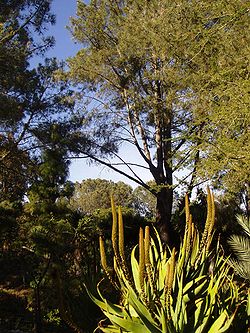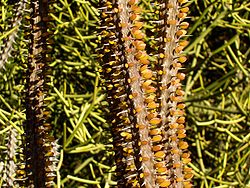
Quail Botanical Gardens
Encyclopedia


Botanical garden
A botanical garden The terms botanic and botanical, and garden or gardens are used more-or-less interchangeably, although the word botanic is generally reserved for the earlier, more traditional gardens. is a well-tended area displaying a wide range of plants labelled with their botanical names...
in Encinitas, California
Encinitas, California
Encinitas is a coastal beach city in San Diego County, California. Located within Southern California, it is approximately north of San Diego in North County and about south of Los Angeles. As of the 2010 census, the city had a population of 59,518, up from 58,014 at the 2000 census. Encinitas is...
, USA
United States
The United States of America is a federal constitutional republic comprising fifty states and a federal district...
. At 37 acres (149,733.8 m²), the garden includes rare bamboo
Bamboo
Bamboo is a group of perennial evergreens in the true grass family Poaceae, subfamily Bambusoideae, tribe Bambuseae. Giant bamboos are the largest members of the grass family....
groves (said to be the largest bamboo collection in the United States), desert gardens, a tropical rainforest
Rainforest
Rainforests are forests characterized by high rainfall, with definitions based on a minimum normal annual rainfall of 1750-2000 mm...
, California native plants, Mediterranean climate landscapes, and a subtropical fruit
Fruit
In broad terms, a fruit is a structure of a plant that contains its seeds.The term has different meanings dependent on context. In non-technical usage, such as food preparation, fruit normally means the fleshy seed-associated structures of certain plants that are sweet and edible in the raw state,...
garden. The gardens are open to the public daily. The name of the facility was changed in 2009 to better reflect the garden's status as a regional attraction.
Explore four miles of garden trails, enjoy restful vistas, flowering trees, majestic palms, and the nation’s largest bamboo collection. Thanks to the mild climate, plants from all over the world thrive. The diverse topography provides a variety of microclimates giving the visitor a sensation of going from a desert environment to a tropical rainforest.
Located 30 minutes north of San Diego in Encinitas, California, San Diego Botanic Garden features numerous exhibits, including rare bamboo groves, desert gardens, a tropical rainforest, California native plants, Mediterranean climate landscapes, succulent gardens, an herb garden, firesafe landscaping, a subtropical fruit garden, and native coastal sage natural areas. The Hamilton Children's Garden was opened in June 2011, the largest interactive children's garden on the West Coast.
Until 1957 the gardens were the private estate of Ruth Baird Larabee, at which time she donated her house and grounds to the County of San Diego
San Diego County, California
San Diego County is a large county located in the southwestern corner of the US state of California. Hence, San Diego County is also located in the southwestern corner of the 48 contiguous United States. Its county seat and largest city is San Diego. Its population was about 2,813,835 in the 2000...
. The Quail Botanical Gardens Foundation was established in 1961.
Today the gardens include nearly 3,000 varieties of tropical, subtropical, and California native plants
California native plants
California native plants are plants that existed in California prior to the arrival of European explorers and colonists in the late 18th century...
. Collections include the climate-based gardens for the New World and Old World Desert, Coastal Sage
Sagebrush
Sagebrush is a common name of a number of shrubby plant species in the genus Artemisia native to western North America;Or, the sagebrush steppe ecoregion, having one or more kinds of sagebrush, bunchgrasses and others;...
Scrub, Sub-Tropical Fruit, a Pinetum, a Palm Canyon, as well as geographically organized gardens for Africa
Africa
Africa is the world's second largest and second most populous continent, after Asia. At about 30.2 million km² including adjacent islands, it covers 6% of the Earth's total surface area and 20.4% of the total land area...
, Australia
Australia
Australia , officially the Commonwealth of Australia, is a country in the Southern Hemisphere comprising the mainland of the Australian continent, the island of Tasmania, and numerous smaller islands in the Indian and Pacific Oceans. It is the world's sixth-largest country by total area...
, Arid Madagascar
Madagascar
The Republic of Madagascar is an island country located in the Indian Ocean off the southeastern coast of Africa...
Garden, Arid South America
South America
South America is a continent situated in the Western Hemisphere, mostly in the Southern Hemisphere, with a relatively small portion in the Northern Hemisphere. The continent is also considered a subcontinent of the Americas. It is bordered on the west by the Pacific Ocean and on the north and east...
, the Canary Islands
Canary Islands
The Canary Islands , also known as the Canaries , is a Spanish archipelago located just off the northwest coast of mainland Africa, 100 km west of the border between Morocco and the Western Sahara. The Canaries are a Spanish autonomous community and an outermost region of the European Union...
, Cape South Africa
South Africa
The Republic of South Africa is a country in southern Africa. Located at the southern tip of Africa, it is divided into nine provinces, with of coastline on the Atlantic and Indian oceans...
, Central America
Central America
Central America is the central geographic region of the Americas. It is the southernmost, isthmian portion of the North American continent, which connects with South America on the southeast. When considered part of the unified continental model, it is considered a subcontinent...
, the Himalayas
Himalayas
The Himalaya Range or Himalaya Mountains Sanskrit: Devanagari: हिमालय, literally "abode of snow"), usually called the Himalayas or Himalaya for short, is a mountain range in Asia, separating the Indian subcontinent from the Tibetan Plateau...
, the Mediterranean, the Middle East
Middle East
The Middle East is a region that encompasses Western Asia and Northern Africa. It is often used as a synonym for Near East, in opposition to Far East...
, New Zealand
New Zealand
New Zealand is an island country in the south-western Pacific Ocean comprising two main landmasses and numerous smaller islands. The country is situated some east of Australia across the Tasman Sea, and roughly south of the Pacific island nations of New Caledonia, Fiji, and Tonga...
, the Pan-Tropical Rainforest
Rainforest
Rainforests are forests characterized by high rainfall, with definitions based on a minimum normal annual rainfall of 1750-2000 mm...
with a 60-foot waterfall, and the Pacific.
Plant varieties include fuchsias
Fuchsia
Fuchsia is a genus of flowering plants that consists mostly of shrubs or small trees. The first, Fuchsia triphylla, was discovered on the Caribbean island of Hispaniola in 1703 by the French Minim monk and botanist, Charles Plumier...
, hibiscus
Hibiscus
Hibiscus is a genus of flowering plants in the mallow family, Malvaceae. It is quite large, containing several hundred species that are native to warm-temperate, subtropical and tropical regions throughout the world...
, bamboo
Bamboo
Bamboo is a group of perennial evergreens in the true grass family Poaceae, subfamily Bambusoideae, tribe Bambuseae. Giant bamboos are the largest members of the grass family....
s, proteas
Protea
Protea is both the botanical name and the English common name of a genus of flowering plants, sometimes also called sugarbushes.-Etymology:...
, cacti
Cactus
A cactus is a member of the plant family Cactaceae. Their distinctive appearance is a result of adaptations to conserve water in dry and/or hot environments. In most species, the stem has evolved to become photosynthetic and succulent, while the leaves have evolved into spines...
and succulents, as well as other drought-resistant plants including Australian shrubs. Herbs, water plants, wildflowers, perennials, brugmansias
Brugmansia
Brugmansia is a genus of seven species of flowering plants in the family Solanaceae, native to subtropical regions of South America, along the Andes from Colombia to northern Chile, and also in southeastern Brazil. They are known as Angel's Trumpets, sharing that name with the closely related genus...
, cork oaks, and palms
Arecaceae
Arecaceae or Palmae , are a family of flowering plants, the only family in the monocot order Arecales. There are roughly 202 currently known genera with around 2600 species, most of which are restricted to tropical, subtropical, and warm temperate climates...
are also featured.
Of particular interest is the maturing Cork Oak (Quercus suber) forest. Paths wind through a cluster of twisted and majestic trees whose bark has been used for making corks for thousands of years.
Hours
9:00 am – 5:00 pm Daily
Extended summer hours,
open to 8:00 pm Thursdays
Admission
Adults $12
Seniors, students, active military $8
Children ages 3-12 $6
Members; children ages 2 & under FREE
Parking $2*
Go Green Policy - 4 or more in a car, park free*
- Members park free.

